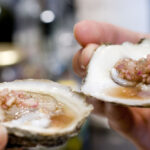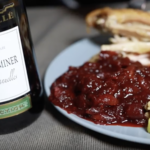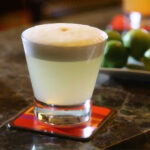
Editor’s note: Silvia Balidini will be sharing her remixes with us monthly here at Wine4Food, where she cooks time-honored recipes, and then reimagines them with a modern spin. We’ll share both the traditional and the remixed recipes, as well as Silvia’s wonderful stories.
I grew up in Piedmont, the tranquil region nestled in the north-west corner of Italy, surrounded by tall and rolling hills which are good for growing Barbera grapes.
Barbera is a populist wine, grown in the same viticultural areas of the more famous and prestigious red wines — Barolo, Barbaresco and Nebbiolo. I call Barbera a populist wine not to label it as cheap wine but because of its rustic yet generous character and for its food friendly and flexible characteristics with low tannins and violent red color. Light, tart, bright and fruity, sometimes even bubbly, Barbera has always been the everyday drinking wine on our tables. (A Barbera to try: Palazzo Schiavino Barbera d’Alba.)
I’m very fond of Barbera. I like its bracing acidity, and it was the first wine I got to taste as a child when my father would splash a tiny drop in my water glass at meal time. (That’s how Italians do it.) Barbera is a brilliant companion to many of my recipes because it pairs well with dishes made with rich, fatty sauces, grilled and braised meats, creamy risottos, herbaceous cheeses such as blue cheese, fruity desserts and even tomato-based pasta sauces.
Over the years I have mastered the art of making Brasato, a cult dish from Piedmont. Brasato takes its rich and deeply flavored notes from the Barbera – the cinnamon and bay leaves in which it’s marinated and lovingly slowly cooked. It’s not only one of my mom’s dear recipes, but quite frankly I’m convinced it prompted my husband to propose.

Barbera is a friendly wine and it’s born to be enjoyed with grilled meats in summer— not exclusively under a pergola in Italy but also at a BBQ in the USA—I have remixed my brasato recipe to suit one of my favorite cuts of meat, the flank steak. I’ll share both recipes with you later, but first, I want to tell you that I’m not the only one to appreciate Barbera and its bright personality.
THE EXPERTS
I emailed Eric Asimov, the chief wine critic of The New York Times and I asked his thoughts on Barbera. I have been enthusiastically reading his wine columns for years, so I’m thankful he took the time to share his knowledge and his passion for Barbera with me. He wrote:
“I’ve had a long love affair with Barbera. It was one of my first wine epiphanies back in 1982, when I randomly bought a 1978 Giacomo Conterno Barbera d’Alba in Austin, Texas. The purity and vibrancy of this wine were an unforgettable revelation to me and gave me incentive to always want to enjoy wine as much as I did that bottle. Since then, I’ve happily consumed many Barberas, from young and simple to old and ambitious. The ones I love best are those that do not try to add structure with oak, along with assorted chocolate and vanilla flavors, but which capture the purity of the bright, joyous fruit and allow the acidity to provide the necessary structure. The great Barberas of Conterno, Bartolo Mascarello and Cappellano are no longer the inexpensive bottles of the ’80s, but they are wonderful, as are Barberas from Vietti, Burlotto and many others better known for their Barolos and Barbarescos.”
I’m thrilled to learn this democratic wine from my home country has made a lasting impression on Mr. Asimov. Barbaresco and Nebbiolo are the kings but Barbera is the queen of Piedmont, the birthplace of the Slow Food movement and the home of The University of Gastronomic Sciences, in Pollenzo Bra.
I had the privilege of speaking with Professor Simone Cinotto the associate Professor of Modern History and head of the Master of Gastronomy and World Food Cultures and Mobility Program at UNISG. He is a splendid story teller, born and bred in Piedmont and the lead guitar player and founder of two legendary eighties’ Punk Rock bands in Turin.

This is what he had to say when he called from picturesque Pollenzo:
“La Barbera, elegant, sweet, round (in Italy, Barbera is female) is very dear to me, because it is a local and ancient wine that pours utility and vibrancy in the same glass.”
Professor Cinotto’s father, a proud worker for the Torino’s railways, favored Barbera. Like most men in Piedmont— including my own father and my grandfather, he was in charge of making agnolotti on special occasions. Agnolotti are a small pillow-like ravioli stuffed with leftover braised meat. They are proof that leftover meat is not destined to colorless and overcooked sadness, because in capable and thrifty hands, it’s upcycled into a mouthwatering new meal.
As it often happens when making filled pasta, Professor Cinotto said, his father would be left with an odd-sized piece of dough and extra filling, from which he would shape a single agnolotto, or what it was once known as a: “Priest Bite.” He would thereafter enjoy it submerged in a large glass of zippy Barbera. A perfect example of no-waste domestic gastronomy.
Before hanging up, Professor Cinotto reminded me of a famous song by Italian composer and actor Giorgio Gaber: Barbera e Champagne. He said: “Barbera is for family, champagne is for courtships.” Listen to it. It’s Italian music history and food poetry with a pop.
BARBERA BRASATO

Brasato is the old-world dish to serve on holidays, or when family, and more gather for a long Sunday meal. The secrets of this dish are the cut of meat— an inexpensive marbleized beef chuck or brisket with some connective tissues, are both an excellent choice— then long overnight marinating in the right spices, and of course red wine.
Barolo is for the high holidays but Barbera, with its younger and bright notes, takes it home for me. Brasato requires loving slow cooking, in a covered pot with not too much liquid. It’s served with creamy mashed potatoes or with corn polenta. The sauce is thick, aromatic, and velvety because of the cinnamon, the cloves and the pureed vegetables; I add a shot of cognac to finish the sauce and I reduce it until the alcohol is evaporated. Just remember the flavors and the consistency are always better after a good night’s rest. Make it in advance.
Serves: 6/8 people
Passive Time: overnight
Prep Time: 30 minutes
Cooking Time: 2 ½ -3 hours
Ingredients
2 1/2 pounds beef chuck roast/or brisket
1 Full bottle, 750 ml Barbera wine
1 garlic clove, peeled
2-3 bay leaves
a few whole cardamom cloves, one cinnamon stick, some juniper berries
¼ teaspoon freshly ground nutmeg
handful mixed fresh herbs such as rosemary, sage, thyme tied together with a string
Salt and freshly ground black pepper
2 tablespoons olive oil
2 tablespoons cold butter
1 white onion, diced
1/2 carrot, diced
1 stalk celery, diced
Beef stock
1 shot of cognac
One bunch of parsley leaves, chopped
Directions
Put the beef in a large bowl, add the Barbera wine, the garlic, the bay leaves, the cloves, the cinnamon, the juniper berries, the nutmeg and the tied herbs. Marinate overnight.
When ready to cook, remove the beef from the bowl, pat dry and reserve the marinade. Season the beef with salt and pepper. Tie the beef with kitchen string to help keep its shape during cooking. Heat the olive oil in a large ovenproof pot, such as a Dutch oven. Sear the beef over high heat on all sides until an even brown crust develops. Remove the beef and set aside.
Turn the heat to low. Add the onion, carrot and celery and sweat them gently until the vegetables are soft and translucent, about 10 minutes. Return the beef to the pot, pour the reserved marinade over it, the garlic, all the spices and herbs included. Over medium-heat, bring the pot to a boil and let it reduce, about 5 minutes.
Add beef stock and cover the meat with liquid halfway. Cover with a lid, turn the heat down to low and let simmer gently for about 2 ½ to 3 hours, turning the beef occasionally or braise in a moderate oven (325°F/160°C)
Remove the brasato and set aside on a carving board. Remove and discard the bay leaves, cinnamon and rosemary and the thyme stalks. With an immersion blender puree the vegetables and the liquid until smooth. Boil the sauce over medium-high heat, uncovered, until the sauce is reduced and slightly thickened, about 10 minutes. Drop in the butter and swirl it through the sauce until glossy. Add a shot of cognac and reduce it until the alcohol has evaporated, a couple of minutes. Taste for seasoning, add salt and pepper, if necessary.
Rest the brasato for at least an hour but overnight is best. Slice thin and serve on platter covered with the Barbera sauce and with the chopped parsley.

REMIX: BARBERA GRILLED FLANK STEAK
Then there are times when nothing else but steak will do. Summer is for easy grilling and flank steak is my choice.
Flank demands a good marinade to add flavor but also to promote browning and crispness. It needs high heat quick grilling, a mandatory slice against the grain at an angle, and resting time. I’m here to tell you Barbera is great with grilled meats and it’s best served slightly chilled, making it the perfect BBQ wine.
The marinade from the brasato works wanders to flavor the flank steak. I marinate the meat for thirty minutes to two hours. For rare steak, I grill it on really high heat for three to five minutes on each side, depending on the thickness. Larger steaks might take longer. I reduce the leftover Barbera marinade in a small pot on low heat, I puree it in to a creamy sauce and I serve on the side of the flank steak.
A time-honored recipe remixed in one fool-proof, vibrant and modern summer dish. Nothing lost in the past and a lot gained for the future.
A quick tip: summer is for juicy peaches and effortless desserts. Peel a couple of ripe peaches and cover them with a generous amount of Barbera, add one tablespoon of sugar and the juice of half a lemon. Macerate them for half an hour and enjoy with a hunk of cobalt blue gorgonzola. You’ll thank me.
BARBERA GRILLED FLANK STEAK
Serves: 4/6 people
Passive Time: 30 minutes to 2 hours
Prep Time: 30 minutes
Cooking Time: 3 to 6 minutes per side
Ingredients
1 white onion, diced
1/2 carrot, diced
1 stalk celery, diced
1 tablespoons olive oil
1 Full Bottle, 750 ml Barbera wine
1 garlic clove, peeled
2-3 bay leaves
A few whole cardamom cloves, one cinnamon stick, some juniper berries
¼ teaspoon freshly ground nutmeg
1 handful mixed fresh herbs such as rosemary, sage, thyme tied together with a string
Beef stock
2 tablespoons cold butter
1 shot of cognac
One 16- to 24-ounce flank steak
Salt and freshly ground black pepper
One bunch of parsley leaves, chopped
Directions
Marinade:
Sweat the onion, carrot and celery with the olive oil until translucent in medium-large pot.
Add the Barbera wine, the garlic, the bay leaves, the cloves, the cinnamon, the juniper berries, the nutmeg and the tied herbs. Cook on medium heat for about 10 minutes. Add the beef stock and cook for another 5 to 7 minutes.
Remove and discard bay the leaves, cinnamon and rosemary and the thyme stalks. With an immersion blender puree the vegetables and the liquid until smooth. Boil the sauce over medium-high heat, uncovered, until the sauce is reduced and slightly thickened, about 10 minutes. Drop in the butter and swirl it through the sauce until glossy. Add a shot of cognac and reduce it until the alcohol has evaporated, about two minutes. Taste for seasoning, add salt and pepper, if necessary. It can be prepared a day in advanced. Keep refrigerated until ready to use.
Flank Steak:
Season the flank steak on both sides with salt and pepper. Place the steak in the Barbera sauce and turn once or twice, then let sit in the sauce until the grill is hot.
Turn the steak one more time, then place on the grill; brush a couple of tablespoons with the Barbera sauce over it, reserve the rest of the sauce. For rare meat, grill about 3 minutes a side for steaks less than an inch thick. For larger or more done steak, increase the time slightly.
Rest the steak for 10 minutes and slice at a diagonal, against the grain. Serve with the chopped parsley and the reserved sauce on the side.

Silvia Baldini is a former advertising art director and an Italian-born classically trained chef known for her work with popular Italian ingredients. She is a Chopped Champion on Food Network and the founder of The Secret Ingredient Girls and Strawberry & Sage. Following a distinguished and award-winning career as an Art Director on Madison Avenue, Silvia pursued culinary training at ICC in NYC and graduated first in class at Cordon Bleu in London.
Her work and recipes have been published in Food & Wine, Bon Appetit, Parents Magazine, Reader’s Digest, Thrillist, Country Magazine, Saveur, The Wall Street Journal and The Independent. Her TV appearances include CNN, ABC, and Dr. Oz. She is a frequent keynote speaker and industry panelist, sharing extensive experience in the food and media industry. Silvia believes that wholesome cooking and traditional wisdom combined with modern technology will be the key to living a happy and healthy life.



